Now that Ukraine has evacuated its fighters from Mariupol, ceding control of the city to Russian forces, we can begin to sort the consequences. One has so far gone largely unexplored — the effect on the production of noble gases.
Azovstal, the besieged steel plant in Mariupol, is one of only a handful of facilities in the world capable of producing the materials needed to cost-effectively make noble gases such as neon, krypton, xenon and helium, which are critical for global manufacturing. What’s needed now is a better understanding of how supply has been hit so that alternative sources can be quickly developed.
Neon, for example, is a key input for the semiconductor manufacturing process. The gas is a byproduct of steel production and is only commercially viable when it’s produced in significant quantities from very large steel plants such as Azovstal. Producers such as Ingas (linked to Mariupol) and Cryoin in Odessa can then pull the neon from the air and make it available for use. But with production at both companies now indefinitely suspended, analysts worry about the supply of neon and other gases, especially to Western manufacturers.
A big problem is that the noble gas market remains dependent on a handful of specialists — firms such as Linde Plc, Air Liquide SA and Air Products and Chemicals Inc. — which prefer to engage in confidential long-term contracts. The lack of transparency has impeded the development of a spot market (where uncontracted supplies can be sold at current market prices) and discouraged natural price discovery.
Since nobody can be sure of current pricing, it’s hard to assess just how much noble gas supply there is. What we do know is that, until the war in Ukraine broke out in 2014, as much as 90% of global neon supply was sourced from Ukraine. The bulk of this came from Mariupol, and most of it went to Western markets.
Cliff Cain, of the Edelgas Group, an independent consultancy, told me that some production has since shifted to China, with Ukraine now probably representing 50% to 70% of global neon production. South Korea’s Posco steel-making company too has begun producing a small amount to cater to domestic demand.
On a recent earnings call, Linde Chief Executive Officer Sanjiv Lamba said his company gets less than 20% of its neon supply from Ukrainian and Russian sources and that it remains well diversified. (Linde and Air Products did not respond to emails asking for comment. A spokeswoman for Air Liquide said the company has no current exposure to Ukrainian or Russian neon markets.)
But if Russia retains control of Mariupol and restarts the city’s damaged plants, 95% of the market could wind up in the hands of just two potentially “unfriendly” players, according to Cain.
Metinvest Group, the mining company of Ukrainian billionaire Rinat Akhmetov, which owns Azovstal as well as the nearby Ilyich steel plant, has said his company is in the process of preparing $10 billion of lawsuits against Russia for the destruction of the two Mariupol facilities. This sum, however, will barely touch the second-order effects if semiconductor manufacturing becomes constrained because of neon shortages.
Also read: Russia prepares for Severodonetsk battle as Ukraine lines up counteroffensive near Izyum
Uncertainty around helium supply — another noble gas needed for semiconductor manufacturing — is also building.
Helium is either sourced from natural deposits in the ground or can be extracted as a byproduct of the gas liquefaction process in the right circumstances. Although production is more diversified, with the US, Qatar and Algeria counting as some of the biggest producers, the helium market nevertheless suffers from significant pricing opacity.
The same specialist companies also dominate. Would-be competitors and buyers claim that, in many cases, they make agreements on loss-leading terms to capture broader gas supply business, preventing price discovery. What little uncontracted supply exists is currently being quoted at five times the usual rate, says Edelgas’s Cain — a figure confirmed to me by Stefano Marani, the CEO of South Africa-based Renergen, an independent helium and natural gas producer.
Since the noble gas market’s troubles predate the war in Ukraine, it’s hard not to blame market structure for current circumstances. But sometimes a squeeze is just what’s needed to encourage transparency.
It was market tightness following the 1979 Iranian revolution that finally skewered the grip of the Seven Sisters cartel — the group of Western oil producers that dominated long-term contracting in the market — and allowed an active oil spot market to emerge.
More recently, the liquefied natural gas (LNG) market opened in the wake of market tightness caused by the 2011 Fukushima disaster and the post-Arab Spring decline in Egyptian gas production. The market has moved gracefully from a “take or pay” type system indexed to oil prices to one in which spot cargoes now dominate, encouraging better price visibility and understanding of supply-side dynamics.
The noble gas market would be wise to follow suit.
A good first step would be for Western governments to call for more transparency from the big companies about how much supply has been hurt by the war, and how much is still being sourced from either disputed territories or those that pose a risk of being sanctioned.
Market participants should also support the development of new platforms that allow them to post bids to woo supply and cover shortages, or urge existing exchanges to support noble gas quotes. The crypto market, for one, is already looking at opportunities in this space. It has convinced Renergen, which is bringing new supply to market from this year onwards, to sell its volumes in tokenized form.
Whatever the path to a spot market, it’s becoming increasingly clear that gases such as neon and helium are too important to be under the thumb of only a few big players. Noble gases should be allowed to float freely on the market. –-Bloomberg
Also read: West must decide the end goal of war. Ukraine is being destroyed
